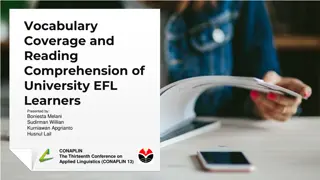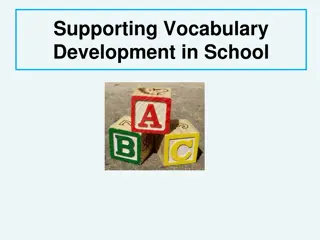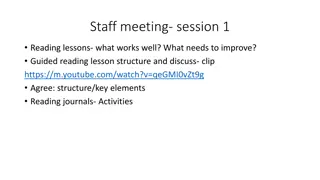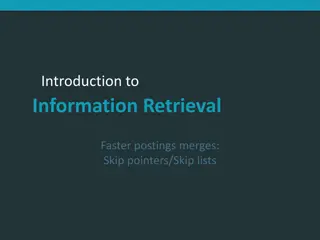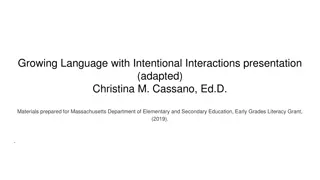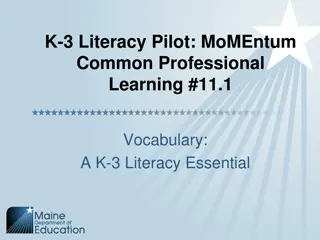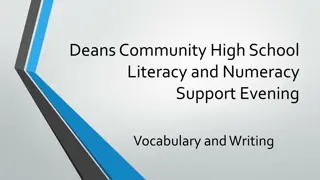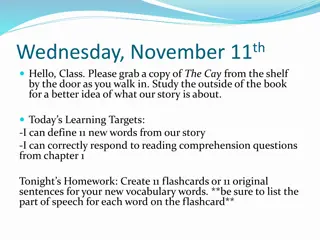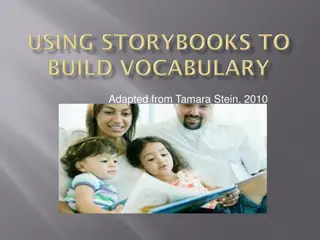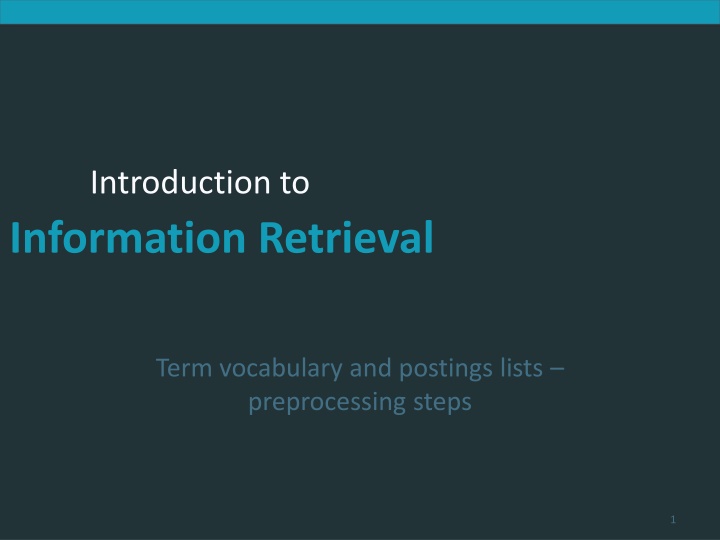
Retrieval: Term Vocabulary, Postings Lists, and Preprocessing Steps
Explore the fundamentals of information retrieval, including parsing documents, handling format and language complexities, defining key terms like word and token, and constructing inverted indexes. Gain insights into the challenges of indexing multilingual and multifaceted documents.
Download Presentation

Please find below an Image/Link to download the presentation.
The content on the website is provided AS IS for your information and personal use only. It may not be sold, licensed, or shared on other websites without obtaining consent from the author. If you encounter any issues during the download, it is possible that the publisher has removed the file from their server.
You are allowed to download the files provided on this website for personal or commercial use, subject to the condition that they are used lawfully. All files are the property of their respective owners.
The content on the website is provided AS IS for your information and personal use only. It may not be sold, licensed, or shared on other websites without obtaining consent from the author.
E N D
Presentation Transcript
Introduction to Information Retrieval Introduction to Information Retrieval Term vocabulary and postings lists preprocessing steps 1
Introduction to Information Retrieval Documents Last lecture: Simple Boolean retrieval system Our assumptions were: We know what a document is. We can machine-read each document. This can be complex in reality. 2 2
Introduction to Information Retrieval Parsing a document Convert byte sequence into a linear sequence of characters Requirements Deal with format and language of each document What is the encoding? E.g., UTF-8 What format is it in? pdf, word, excel, html, etc. What language is it in? What character set is in use? Each of these is a classification problem Alternative: use heuristics 3 3
Introduction to Information Retrieval Format/Language: Complications A single index usually contains terms of several languages. A document may contain multiple languages/formats French email with Spanish pdf attachment Code switching in social media 4 4
Introduction to Information Retrieval Format/Language: Complications What is the document unit for indexing? A file? An email? An email file can contain a sequence of messages; each message can be considered a document An email with 5 attachments? Multiple files may be combined into one document (ppt or latex in HTML) Upshot: Answering the question what is a document? is not trivial and requires some design decisions. 5 5
Introduction to Information Retrieval Definitions Word A delimited string of characters as it appears in the text Term A normalized word (case, morphology, spelling etc); actually an equivalence class of words; usually what is included in an IR system s dictionary Token An instance of a word or term occurring in a document. Type The same as a term in most cases: an equivalence class of tokens. 6 6
Introduction to Information Retrieval Recall: Inverted index construction Input: Output: Each token is a candidate for a postings entry. What are valid tokens to emit? 7 7
Introduction to Information Retrieval Exercises In June, the dog likes to chase the cat in the barn. How many word tokens? How many word types? Why tokenization is difficult even in English? Tokenize: Mr. O Neill thinks that the boys stories about Chile s capital aren t amusing. 8 8
Introduction to Information Retrieval Tokenization problems: One word or two? (or several) Hewlett-Packard State-of-the-art co-education the hold-him-back-and-drag-him-away maneuver data base San Francisco Los Angeles-based company cheap San Francisco-Los Angeles fares York University vs. New York University 9 9
Introduction to Information Retrieval Tokenization problems: Numbers 3/20/91 20/3/91 Mar 20, 1991 B-52 100.2.86.144 (800) 234-2333 800.234.2333 Older IR systems may not index numbers . . . . . . but generally it s a useful feature. 10 10
Introduction to Information Retrieval Problems in tokenization for other languages, e.g., no whitespace in Chinese 11 11
Introduction to Information Retrieval Ambiguous segmentation in Chinese The two characters can be treated as one word meaning monk or as a sequence of two words meaning and and still . 12 12
Introduction to Information Retrieval Other cases of no whitespace Compounds in Dutch, German, Swedish Computerlinguistik Computer + Linguistik Lebensversicherungsgesellschaftsangestellter leben + versicherung + gesellschaft + angestellter Inuit: tusaatsiarunnanngittualuujunga (I can t hear very well.) Many other languages with segmentation difficulties: Finnish, Urdu, . . . CamelCase in social media 13 13
Introduction to Information Retrieval Japanese 4 different alphabets : Chinese characters, hiragana syllabary for inflectional endings and functional words, katakana syllabary for transcription of foreign words and other uses, and latin. No spaces (as in Chinese). End user can express query entirely in hiragana! 14 14
Introduction to Information Retrieval Arabic script 15 15
Introduction to Information Retrieval Arabic script: Bidirectionality START Algeria achieved its independence in 1962 after 132 years of French occupation. Bidirectionality is not a problem if text is coded in Unicode. 16 16
Introduction to Information Retrieval Accents and diacritics Accents: r sum vs. resume (simple omission of accent) Umlauts: Universit t vs. Universitaet (substitution with special letter sequence ae ) Most important criterion: How are users likely to write their queries for these words? Even in languages that standardly have accents, users often do not type them. (Polish?) 17 17
Introduction to Information Retrieval Case folding Usually: Reduce all letters to lower case Possible exceptions: capitalized words in mid-sentence MIT vs. mit Fed vs. fed It s often best to lowercase everything since users will use lowercase regardless of correct capitalization 18 18
Introduction to Information Retrieval Normalization Need to normalize terms in indexed text as well as query terms into the same form. Example: We want to match U.S.A. and USA We commonly implicitly define equivalence classes of terms Can use hand-constructed rules, e.g., car & automobile Alternatively: do asymmetric expansion window window, windows windows Windows, windows Windows (no expansion) More powerful, but less efficient Why don t you want to put window, Window, windows, and Windows in the same equivalence class? 19 19
Introduction to Information Retrieval Normalization: Other languages Normalization and language detection interact. PETER WILL NICHT MIT. MIT = mit He got his PhD from MIT. MIT mit 20 20
Introduction to Information Retrieval Stop words stop words: extremely common words which would appear to be of little value in helping select documents matching a user need Examples: a, an, and, are, as, at, be, by, for, from, has, he, in, is, it, its, of, on, that, the, to, was, were, will, with Stop word elimination used to be standard in older IR systems. But you need stop words for phrase queries, e.g. King of Denmark Most web search engines index stop words. 21 21
Introduction to Information Retrieval Stemming and Lemmatization Goal of both same: reduce inflectional forms and derivationally related forms to a common base form Stemming refers to a heuristic process that chops off the ends of words in the hope of achieving the goal correctly most of the time Lemmatization implies doing proper reduction to dictionary headword form (the lemma), using dictionary and morphological analysis of words 22 22
Introduction to Information Retrieval Lemmatization Reduce inflectional/variant forms to base form Example: am, are, is be Example: car, cars, car s, cars car Example: the boy s cars are different colors the boy car be different color Inflectional morphology (cutting cut) vs. derivational morphology (destruction destroy) 23 23
Introduction to Information Retrieval Stemming Heuristic process that chops off the ends of words in the hope of achieving what principled lemmatization attempts to do with a lot of linguistic knowledge. Language dependent Often inflectional and derivational Example for derivational: automate, automatic, automation all reduce to automat 24 24
Introduction to Information Retrieval Porter algorithm Most common algorithm for stemming English Results suggest that it is at least as good as other stemming options Conventions + 5 phases of reductions Phases are applied sequentially Each phase consists of a set of commands. Sample command: Delete final ement if what remains is longer than 1 character replacement replac cement cement Sample convention: Of the rules in a compound command, select the one that applies to the longest suffix. 25 25
Introduction to Information Retrieval Porter stemmer: A few rules Example caresses caress ponies poni caress caress cats cat Rule SSES SS IES I SS SS S 26 26
Introduction to Information Retrieval Three stemmers: A comparison Sample text: biologically transparent and accessible to interpretation Porter stemmer: such an analysi can reveal featur that ar not easili visibl from the variat in the individu gene and can lead to pictur of express that is more biolog transpar and access to interpret Lovins stemmer: such an analys can reve featur that ar not eas vis from th vari in th individu gen and can lead to a pictur of expres that is mor biolog transpar and acces to interpres Paice stemmer: such an analys can rev feat that are not easy vis from the vary in the individ gen and can lead to a pict of express that is mor biolog transp and access to interpret Such an analysis can reveal features that are not easily visible from the variations in the individual genes and can lead to a picture of expression that is more 27 27
Introduction to Information Retrieval Does stemming improve effectiveness? In general, stemming increases effectiveness for some queries, and decreases effectiveness for others. Queries where stemming is likely to help: [tartan sweaters], [sightseeing tour san francisco] (equivalence classes: {sweater,sweaters}, {tour,tours}) Porter Stemmer equivalence class oper contains all of operate operating operates operation operative operatives operational. Queries where stemming hurts: [operational AND research], [operating AND system], [operative AND dentistry] 28 28




